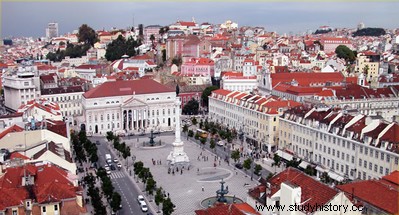By Tales Pinto
The Portuguese Revolution of 1974-1975 ended 48 years of Antônio Salazar's fascist regime, inaugurating the democratic period of the country's political history. But this democracy was conquered after an intense process of social struggles led by workers in factories, fields and poor urban neighborhoods.
 ?
?
The capital Lisbon was one of the places where the struggles of industrial workers and the struggle for housing took place
The coup carried out on April 25, 1975 by the Armed Forces Movement (MFA) opened up possibilities for the practical expression of demands that for many years had been contained by Salazar's repression. Marcelo Caetano's withdrawal from power and the beginning of the Provisional Governments opened up possibilities of organization for workers, which ended up generating a strong autonomous movement. The main characteristic was the constitution of Commissions to organize the presentation of the demands to the bosses and, later, with the flight of many of them out of the country or even with the closing of the factories, the workers started to manage the production in the companies through these commissions. . With self-management or even with workers' control of production, workers were able to maintain industrial production in a period of serious economic crisis.
A similar movement took place in the countryside, mainly in the south of the country, an area of large estates that saw salaried workers occupy the land to carry out agrarian reform. After the occupation of the lands, the workers created Collective Production Units and also cooperatives with the objective of guaranteeing wages and jobs. The result was an increase in agricultural production and a stimulus to the industrial production of commodities necessary for agriculture, such as fertilizers and agricultural tools.
In poor neighborhoods, the revolutionary movement stimulated the struggle for better housing conditions. The “slums”, as the poor neighborhoods of large cities were known, did not have ideal housing conditions, which led the residents, after the April 25, 1974 coup, to occupy a large number of houses and demand improvements. in housing conditions.
The struggles for political state power mobilized several parties, and initially the Portuguese Communist Party (PCP) gained greater strength, with the support of sectors to the left of the MFA, leading to the nationalization of the financial system and other companies after March 11, 1975.
These three types of struggle that marked the period between April 1974 and November 1975 gave the Carnation Revolution a strong popular character and the direct participation of workers in the attempts of reorganizing their lives. However, on November 25, 1975, conservative groups in the army reacted to an attempted coup by the extreme left and, with a counter-coup supported by the Socialist Party, managed to use the institutional apparatus of the state to contain the actions of the workers. With this, they consolidated the system of representative democracy in force at the beginning of the 21st century.
